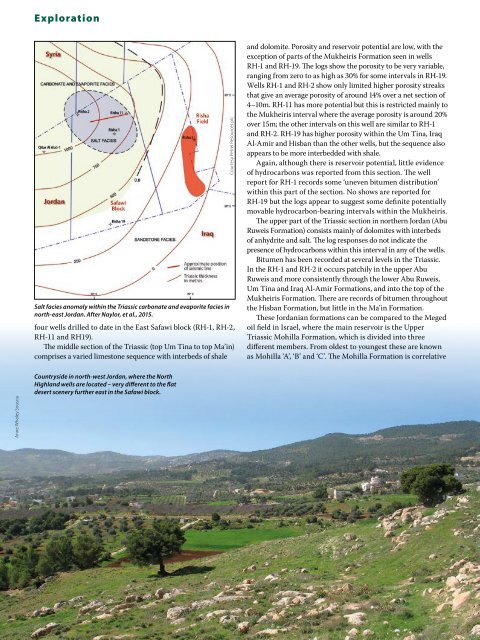Iraqi Kurdistan All in the Timing
GEO_ExPro_v12i6
GEO_ExPro_v12i6
You also want an ePaper? Increase the reach of your titles
YUMPU automatically turns print PDFs into web optimized ePapers that Google loves.
Exploration<br />
Salt facies anomaly with<strong>in</strong> <strong>the</strong> Triassic carbonate and evaporite facies <strong>in</strong><br />
north-east Jordan. After Naylor, et al., 2015.<br />
four wells drilled to date <strong>in</strong> <strong>the</strong> East Safawi block (RH-1, RH-2,<br />
RH-11 and RH19).<br />
The middle section of <strong>the</strong> Triassic (top Um T<strong>in</strong>a to top Ma’<strong>in</strong>)<br />
comprises a varied limestone sequence with <strong>in</strong>terbeds of shale<br />
Courtesy Petrel Resources plc<br />
and dolomite. Porosity and reservoir potential are low, with <strong>the</strong><br />
exception of parts of <strong>the</strong> Mukheiris Formation seen <strong>in</strong> wells<br />
RH-1 and RH-19. The logs show <strong>the</strong> porosity to be very variable,<br />
rang<strong>in</strong>g from zero to as high as 30% for some <strong>in</strong>tervals <strong>in</strong> RH-19.<br />
Wells RH-1 and RH-2 show only limited higher porosity streaks<br />
that give an average porosity of around 14% over a net section of<br />
4–10m. RH-11 has more potential but this is restricted ma<strong>in</strong>ly to<br />
<strong>the</strong> Mukheiris <strong>in</strong>terval where <strong>the</strong> average porosity is around 20%<br />
over 15m; <strong>the</strong> o<strong>the</strong>r <strong>in</strong>tervals on this well are similar to RH-1<br />
and RH-2. RH-19 has higher porosity with<strong>in</strong> <strong>the</strong> Um T<strong>in</strong>a, Iraq<br />
Al-Amir and Hisban than <strong>the</strong> o<strong>the</strong>r wells, but <strong>the</strong> sequence also<br />
appears to be more <strong>in</strong>terbedded with shale.<br />
Aga<strong>in</strong>, although <strong>the</strong>re is reservoir potential, little evidence<br />
of hydrocarbons was reported from this section. The well<br />
report for RH-1 records some ‘uneven bitumen distribution’<br />
with<strong>in</strong> this part of <strong>the</strong> section. No shows are reported for<br />
RH-19 but <strong>the</strong> logs appear to suggest some def<strong>in</strong>ite potentially<br />
movable hydrocarbon-bear<strong>in</strong>g <strong>in</strong>tervals with<strong>in</strong> <strong>the</strong> Mukheiris.<br />
The upper part of <strong>the</strong> Triassic section <strong>in</strong> nor<strong>the</strong>rn Jordan (Abu<br />
Ruweis Formation) consists ma<strong>in</strong>ly of dolomites with <strong>in</strong>terbeds<br />
of anhydrite and salt. The log responses do not <strong>in</strong>dicate <strong>the</strong><br />
presence of hydrocarbons with<strong>in</strong> this <strong>in</strong>terval <strong>in</strong> any of <strong>the</strong> wells.<br />
Bitumen has been recorded at several levels <strong>in</strong> <strong>the</strong> Triassic.<br />
In <strong>the</strong> RH-1 and RH-2 it occurs patchily <strong>in</strong> <strong>the</strong> upper Abu<br />
Ruweis and more consistently through <strong>the</strong> lower Abu Ruweis,<br />
Um T<strong>in</strong>a and Iraq Al-Amir Formations, and <strong>in</strong>to <strong>the</strong> top of <strong>the</strong><br />
Mukheiris Formation. There are records of bitumen throughout<br />
<strong>the</strong> Hisban Formation, but little <strong>in</strong> <strong>the</strong> Ma’<strong>in</strong> Formation.<br />
These Jordanian formations can be compared to <strong>the</strong> Meged<br />
oil field <strong>in</strong> Israel, where <strong>the</strong> ma<strong>in</strong> reservoir is <strong>the</strong> Upper<br />
Triassic Mohilla Formation, which is divided <strong>in</strong>to three<br />
different members. From oldest to youngest <strong>the</strong>se are known<br />
as Mohilla ‘A’, ‘B’ and ‘C’. The Mohilla Formation is correlative<br />
Anne Whaley Sousou<br />
Countryside <strong>in</strong> north-west Jordan, where <strong>the</strong> North<br />
Highland wells are located – very different to <strong>the</strong> flat<br />
desert scenery fur<strong>the</strong>r east <strong>in</strong> <strong>the</strong> Safawi block.<br />
56 GEOExPro November 2015


